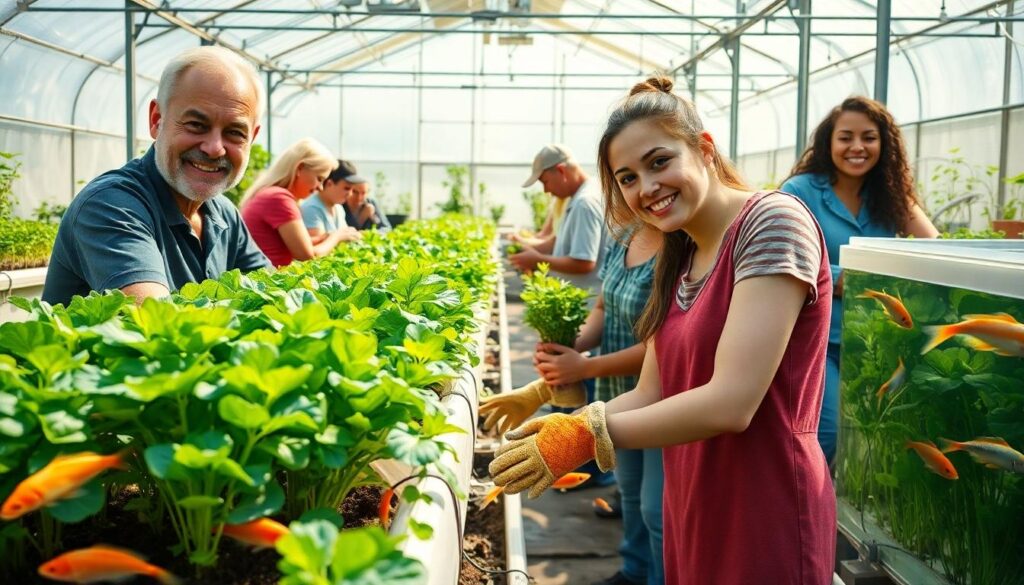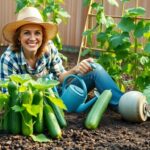Imagine growing fresh vegetables while raising fish in the same system. That’s exactly what aquaponics offers—a revolutionary method that combines aquaculture (fish farming) and hydroponics (soil-less plant growing) in one sustainable network.
We’ve discovered that aquaponics creates the perfect symbiotic relationship: fish waste provides essential nutrients for plants, while plants naturally filter the water for the fish. This closed-loop system uses 90% less water than traditional gardening methods and produces food twice as fast. Whether you’re looking to become more self-sufficient or simply want fresher produce, aquaponics might be the solution you’ve been searching for.
Understanding the Basics of Aquaponics: Fish and Plants Working Together
Aquaponics operates on a beautifully simple principle where fish and plants create a mutually beneficial network. The system relies on three main living components that work in harmony: fish, plants, and beneficial bacteria. Fish produce ammonia-rich waste that would become toxic if left to accumulate. Bacteria then convert this ammonia into nitrates, which serve as perfect nutrients for plants. Plants absorb these nitrates while filtering the water, which returns clean to the fish tank.
The nitrogen cycle forms the foundation of every successful aquaponics system. First, fish excrete ammonia through their gills and waste. Next, beneficial bacteria (Nitrosomonas) convert this ammonia to nitrites. Then, another type of bacteria (Nitrobacter) transforms nitrites into nitrates. Finally, plants use these nitrates as essential nutrients for growth.
Water circulation plays a critical role in maintaining this delicate balance. Most systems use simple pumps to move water from the fish tank to the grow beds. The water flows through the plant roots, depositing nutrients and picking up oxygen. This continuous circulation ensures fresh, nutrient-rich water reaches plants while returning clean, oxygenated water to the fish.
Temperature management affects both fish health and plant growth in aquaponics systems. Most setups maintain water temperatures between 68-86°F (20-30°C) to accommodate both components. Fish species like tilapia thrive in warmer temperatures, while trout prefer cooler conditions. Plants also have exact temperature preferences, which impacts which combinations work best together.
pH balance requires regular monitoring in aquaponics systems. The ideal pH range typically falls between 6.8-7.0, which represents a compromise between fish (preferring 7.0-7.5) and plants (preferring 5.5-6.5). Maintaining this balance ensures nutrients remain available to plants while keeping fish healthy.
Stocking density directly impacts system productivity and requires careful consideration. Most home systems maintain approximately 1 pound of fish per 5-10 gallons of water. Overcrowding leads to oxygen depletion and excess ammonia, while understocking might not provide sufficient nutrients for plant growth.
The Science Behind Aquaponics: How the Fish-Plant Ecosystem Functions
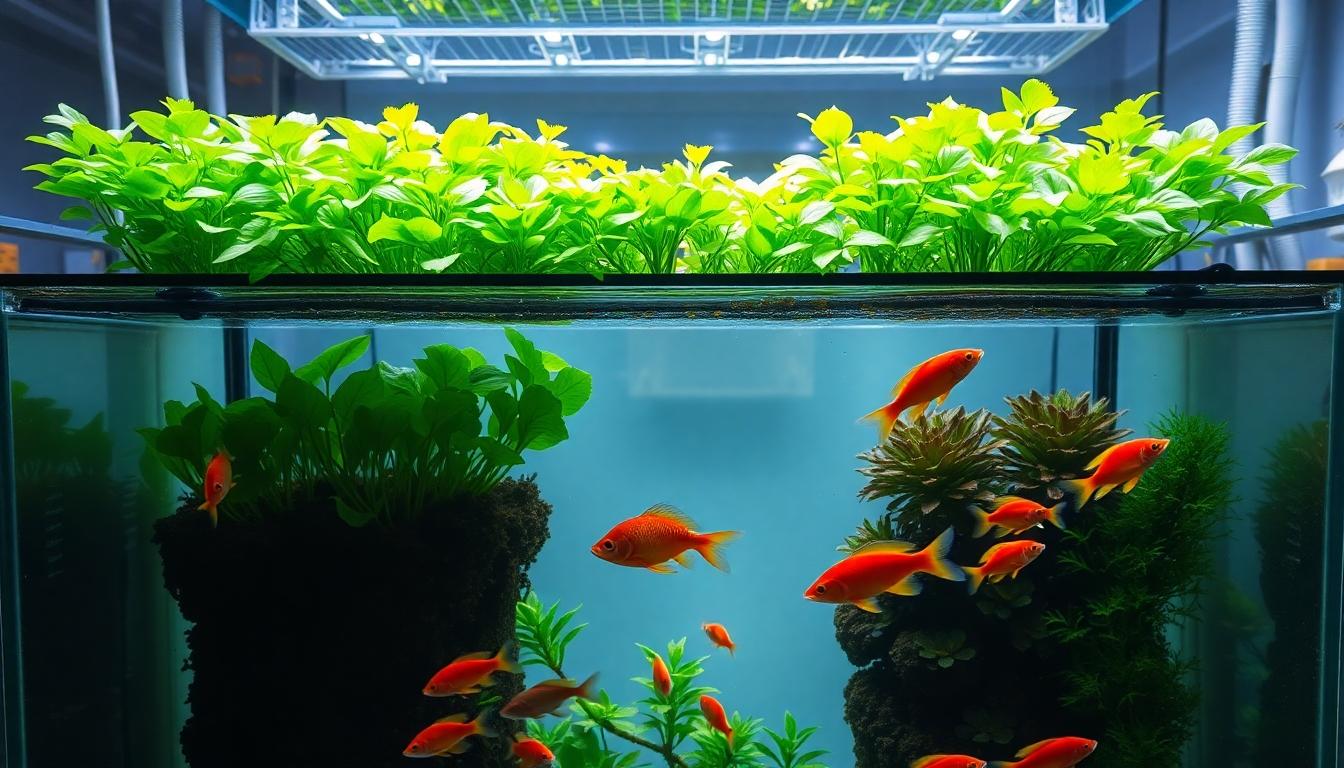
Aquaponics represents a remarkable closed-loop system that combines aquaculture (fish farming) and hydroponics (soilless plant cultivation) into a mutually beneficial network. Within this integrated environment, fish, plants, and bacteria work together in perfect harmony, creating a sustainable food production method that mimics natural ecosystems.
The Nitrogen Cycle in Aquaponics Systems
The nitrogen cycle forms the backbone of every successful aquaponics system, transforming fish waste into valuable plant nutrition. Fish naturally produce ammonia-rich waste which, if left untreated, would become toxic to the aquatic environment. This waste enters the first stage of the cycle when it’s released into the water along with uneaten fish feed. Beneficial bacteria then convert this ammonia into nitrites through a process called nitrification, with specialized Nitrosomonas bacteria leading this transformation. Additional bacteria (Nitrobacter) further oxidize these nitrites into nitrates, creating the primary nitrogen source that plants crave for healthy growth. Plants actively absorb these nitrates through their root systems, effectively filtering toxins from the water and completing the purification process. Clean, oxygenated water then recirculates back to the fish tanks, creating a continuous cycle that benefits all organisms in the system.
Beneficial Bacteria and Their Role in Nutrient Conversion
Nitrifying bacteria serve as the unsung heroes of aquaponics, making the entire network possible through their remarkable conversion capabilities. These microscopic organisms colonize various surfaces throughout the system, including grow beds, biofilters, and tank walls, forming extensive biological filtration networks. Without these bacteria, ammonia would quickly accumulate to dangerous levels, harming fish while simultaneously depriving plants of essential nutrients. Maintaining optimal conditions for bacterial growth requires careful attention to water parameters, with ideal pH levels between 6.7–7.0 and temperatures ranging from 75–85°F. Bacteria need oxygen-rich water and ample surface area to develop healthy biofilms that support their metabolic functions. The relationship between fish, plants, and these beneficial microorganisms demonstrates how waste becomes a resource in aquaponics, eliminating the need for synthetic fertilizers while creating a self-sustaining food production system that uses significantly less water than conventional farming methods.
Top 5 Best Fish Species for Your Aquaponics System
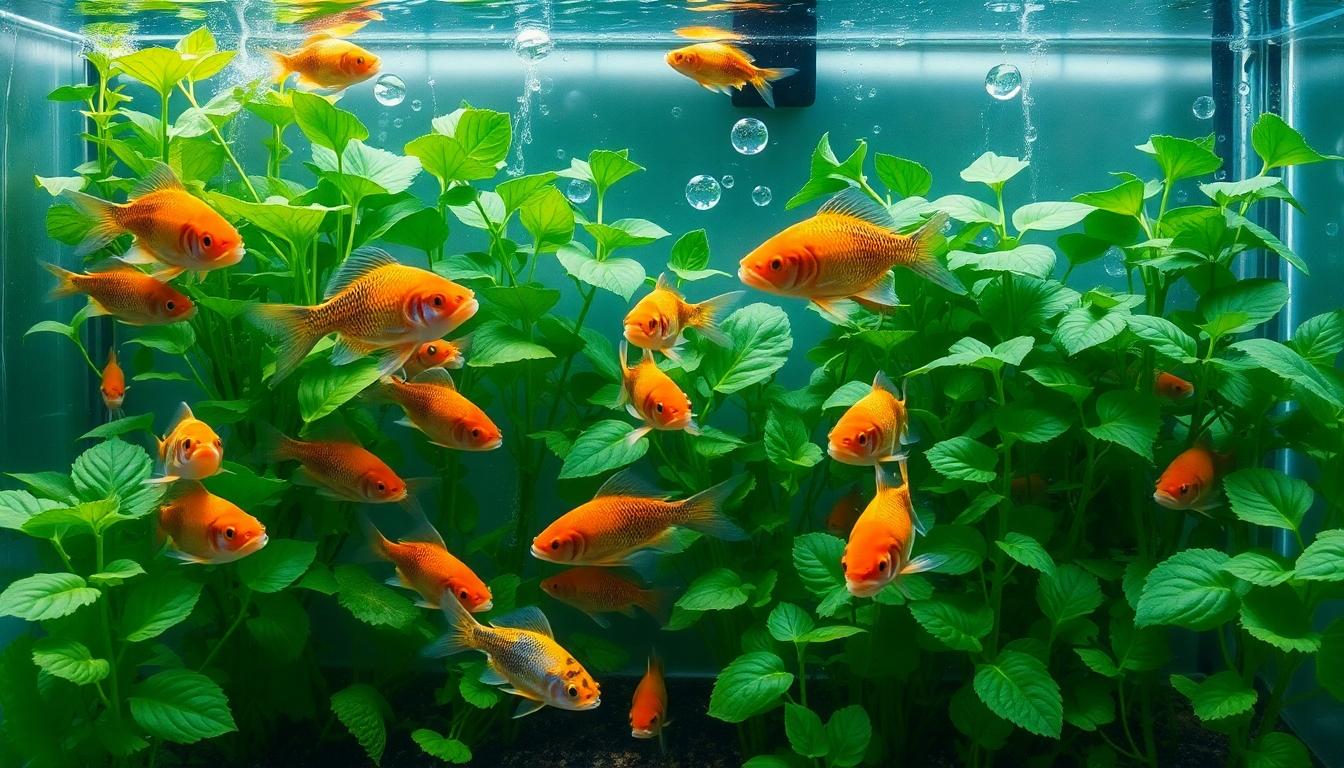
Selecting the right fish species is crucial for a thriving aquaponics system, as different fish have unique requirements and benefits. Here are the top performers that balance waste production, growth rates, and adaptability.
Tilapia: The Aquaponics All-Star
Tilapia stands out as the most popular choice for aquaponics systems, especially in warm climates with water temperatures between 70-85°F. These hardy fish adapt easily to fluctuating conditions while maintaining impressive growth rates, making them perfect for beginners and commercial growers alike. Tilapia produces consistent waste that provides excellent nutrition for leafy greens like lettuce and kale or herbs such as basil and mint. Their resilience to crowding and disease further cements their reputation as the go-to fish for productive aquaponics setups.
Catfish: Hardy and Productive Options
Catfish excel in commercial aquaponics systems due to their remarkable tolerance for fluctuating water parameters and high yield potential. These robust fish thrive in warm water environments and generate substantial nutrient-rich waste, making them ideal partners for nitrogen-demanding plants like tomatoes and peppers. Commercial operators particularly value catfish for their efficient feed conversion ratios and ability to withstand less-than-perfect water conditions. Their adaptability and consistent growth rates ensure reliable production throughout the year.
Trout: Cold Water Aquaponics Champions
Trout offer an excellent option for aquaponics systems in temperate climates, preferring cooler water temperatures between 57-60°F. These cold-water specialists bring high disease resistance to the table but require strict temperature control and enhanced oxygenation to thrive. Trout pair perfectly with cool-season crops such as spinach and Swiss chard, creating a productive system for regions where maintaining warm water would be challenging or costly. Their high protein requirements and oxygen demands mean trout systems need more careful monitoring than some alternatives.
Goldfish and Koi: Ornamental Yet Functional Choices
Goldfish and koi serve as both beautiful and practical options for smaller aquaponics systems, particularly for hobbyists not focused on fish harvest. These ornamental fish tolerate temperature fluctuations remarkably well while producing consistent waste that supports plant growth. Their adaptability makes them suitable for indoor setups and systems with less rigorous monitoring. Fast-growing plants like lettuce and watercress thrive when paired with these colorful swimmers, creating systems that combine aesthetic appeal with functional food production.
Perch and Bluegill: Native Alternatives
Perch and bluegill offer great options for aquaponics enthusiasts seeking native North American fish species that adapt well to controlled environments. Though growing slower than tilapia, these fish bring moderate care requirements and good compatibility with various plants including herbs and vegetables like beans and peas. Their preference for well-oxygenated water means systems should include adequate aeration. Bluegill in particular demonstrates impressive hardiness in established systems, making them valuable additions to diverse aquaponics operations that prioritize local species over exotic alternatives.
Selecting the Right Plants for Your Aquaponics Garden
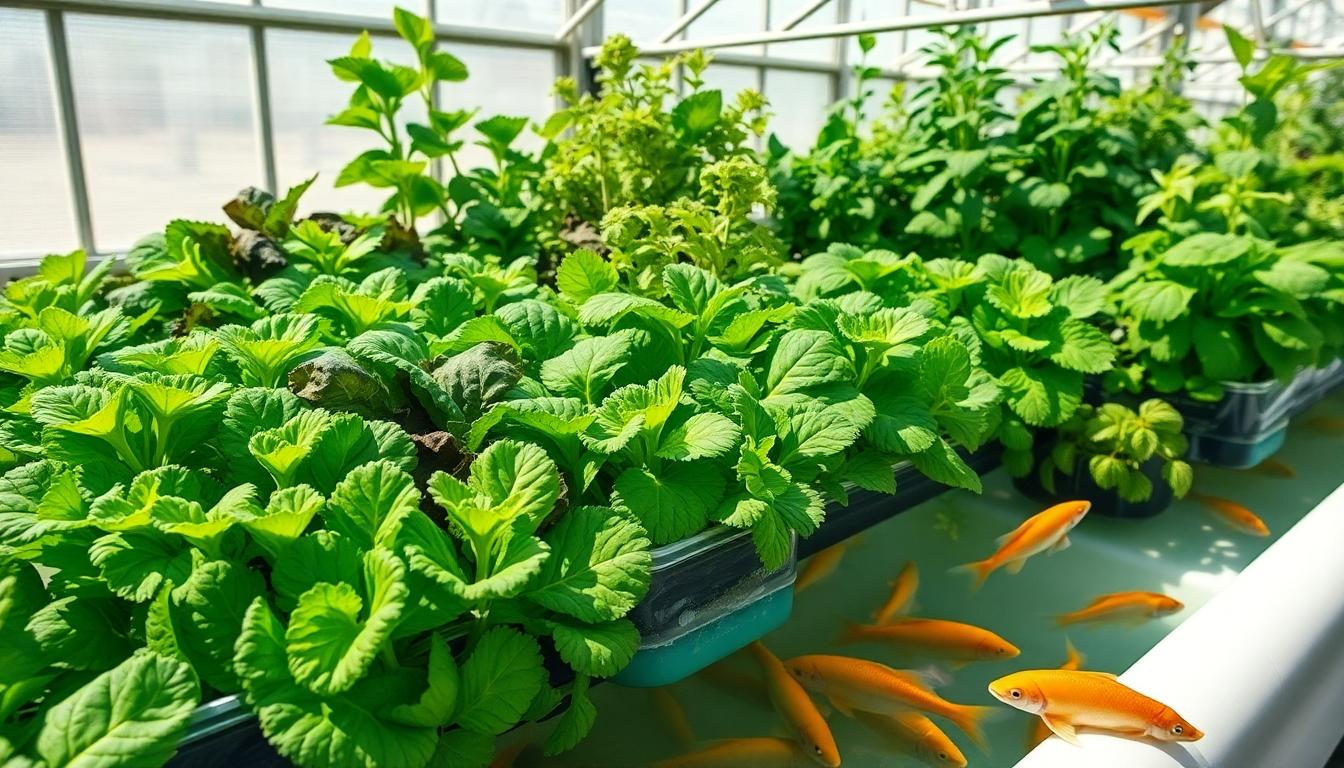
Choosing the right plants for your aquaponics system is crucial for success. The ideal selections depend on your system type, available nutrients, and your experience level.
Leafy Greens That Thrive in Aquaponics
Leafy greens are perfect starter plants for aquaponics systems due to their rapid growth and high nutrient uptake. Lettuce varieties perform exceptionally well in nutrient-rich water and can be harvested continuously throughout the growing season. Kale offers impressive nutritional value while adapting easily to varying pH levels commonly found in aquaponic environments. Spinach grows quickly and requires minimal maintenance, making it ideal for beginners. Swiss chard brings vibrant colors to your system while efficiently filtering water. Watercress naturally grows in flowing water systems, making it perfectly adapted to aquaponics conditions. Cabbage provides substantial yields and thrives in the consistent moisture levels of well-established systems. These greens work best in floating raft and Nutrient Film Technique (NFT) setups.
Herbs That Excel in Aquaponic Systems
Herbs require relatively low nutrient levels, making them excellent choices for newer or smaller aquaponics systems. Basil grows vigorously in aquaponics and pairs wonderfully with fish like tilapia for complementary harvests. Mint spreads quickly and helps maximize production in shallow growing channels. Cilantro offers fast yields and can be harvested multiple times before needing replacement. Rosemary adds aromatic benefits while thriving in the consistent moisture levels provided by NFT setups. These herbs generally perform best in shallow water systems where their roots have access to both nutrients and adequate oxygen.
Fruiting Plants Worth Trying
Fruiting plants demand more established systems with higher nutrient concentrations but reward growers with valuable harvests. Tomatoes flourish in media-based aquaponics beds where their substantial root systems can anchor properly. Peppers, including both bell and chili varieties, produce abundantly when provided with proper support structures and consistent nutrients. Cucumbers climb readily on trellises, making efficient use of vertical space while producing high yields. Dwarf citrus trees like oranges, lemons, and limes can succeed in larger, mature systems with adequate depth and nutrients. Papaya grows surprisingly well in aquaponics when given enough space and nutrient-rich water from well-stocked fish tanks.
Plants to Avoid in Aquaponics
Not all plants adapt well to aquaponic growing conditions even though the system’s versatility. Root vegetables like potatoes and carrots struggle because they require deeper growing media than most aquaponics beds provide. Corn demands extensive nutrients that can deplete even well-stocked systems, potentially stressing fish populations. Plants with extremely deep root systems often face restricted growth in typical aquaponics setups. Water-sensitive species that prefer dry conditions between waterings typically develop root rot in the constantly moist environment. Heavy feeders may compete too aggressively for nutrients, creating imbalances that affect both plant health and fish welfare. Understanding these limitations helps prevent disappointing results and keeps your aquaponics system running smoothly.
Essential Components of a Successful Aquaponics Setup
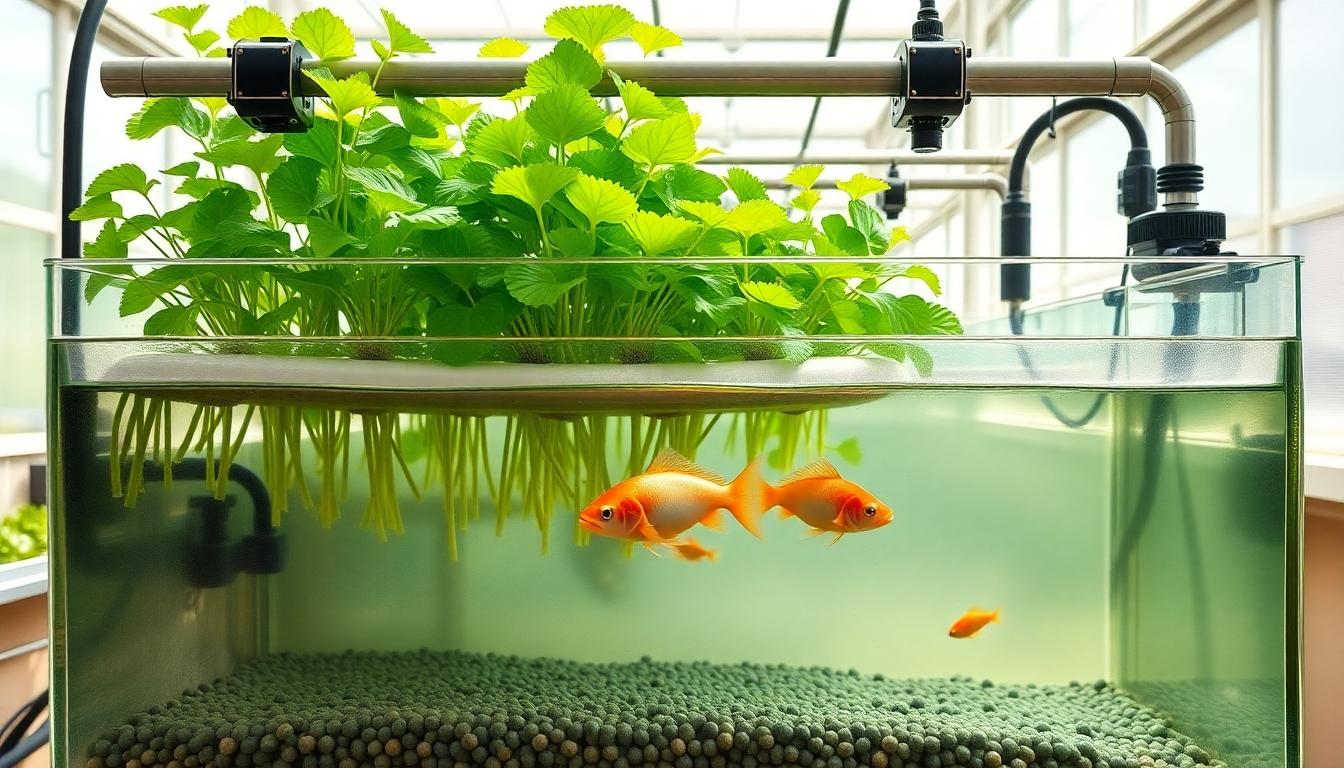
Setting up a proper aquaponics system requires several key components working in harmony to create a thriving network for both fish and plants.
Fish Tanks and Stocking Densities
Proper fish stocking density is crucial for maintaining a balanced aquaponics system. Most successful setups maintain approximately 1 fish per 8-10 gallons of water (or 1 pound of fish per 8-10 gallons) to ensure optimal water quality. Smaller home systems often function well with about 20 liters (5.5 gallons) per fish, providing adequate space for movement and waste production. Mature commercial systems typically operate with 30 fish per 1,000 liters (~265 gallons), creating a stable environment where fish thrive without overcrowding. The ideal stocking density varies based on several factors including fish species selection, water quality parameters, and your system’s filtration capacity. Finding the right balance ensures your fish remain healthy while producing sufficient nutrients for your plants.
Growing Beds and Media Options
Growing beds serve as the foundation for plant development in an aquaponics system. Media-based beds filled with expanded clay pebbles or gravel should measure 25-30 cm in depth to provide adequate support for plant roots. Your media volume directly correlates with the fish capacity you can maintain—a good rule of thumb is approximately 25 liters of wet media for every 500g of fish in your system. Alternative growing methods include floating raft systems or NFT (Nutrient Film Technique) channels, which work particularly well for leafy greens with shallow root systems. Each media type offers different benefits: clay pebbles provide excellent drainage and aeration, while gravel offers durability and cost-effectiveness. The choice of growing media impacts water retention, bacterial colonization, and overall system performance.
Pumps, Filters, and Water Circulation Systems
Water circulation forms the lifeline of your aquaponics system, connecting the fish and plant environments. Effective setups use water pumps that circulate the entire water volume between fish tanks and grow beds in 5-10 minute cycles per hour. Mechanical filters capture solid waste before it reaches the growing area, preventing clogging and maintaining water clarity. Biofilters house the essential nitrifying bacteria that convert toxic ammonia from fish waste into plant-friendly nitrates. Aeration systems must maintain dissolved oxygen levels above 5 mg/L to support fish health and bacterial activity. Properly sized pumps prevent both stagnation and excessive flow, creating the ideal environment for this symbiotic relationship to flourish.
Monitoring Equipment for System Health
Regular monitoring remains essential for maintaining a productive aquaponics system. Test kits should track critical parameters including ammonia, nitrite, and nitrate levels, along with pH which ideally stays between 6.8-7.2 for balanced growth. Dissolved oxygen meters ensure your system maintains proper aeration for fish health and bacterial function. Temperature sensors help maintain appropriate conditions for your exact fish and plant combinations. Automated controllers can simplify management by adjusting pumps, heaters, or aerators based on real-time readings. Daily checks of these parameters allow for early detection of potential issues before they harm your fish or plants. Consistent monitoring creates a stable environment where both fish and plants can thrive together in your aquaponics system.
Different Aquaponics Methods Compared
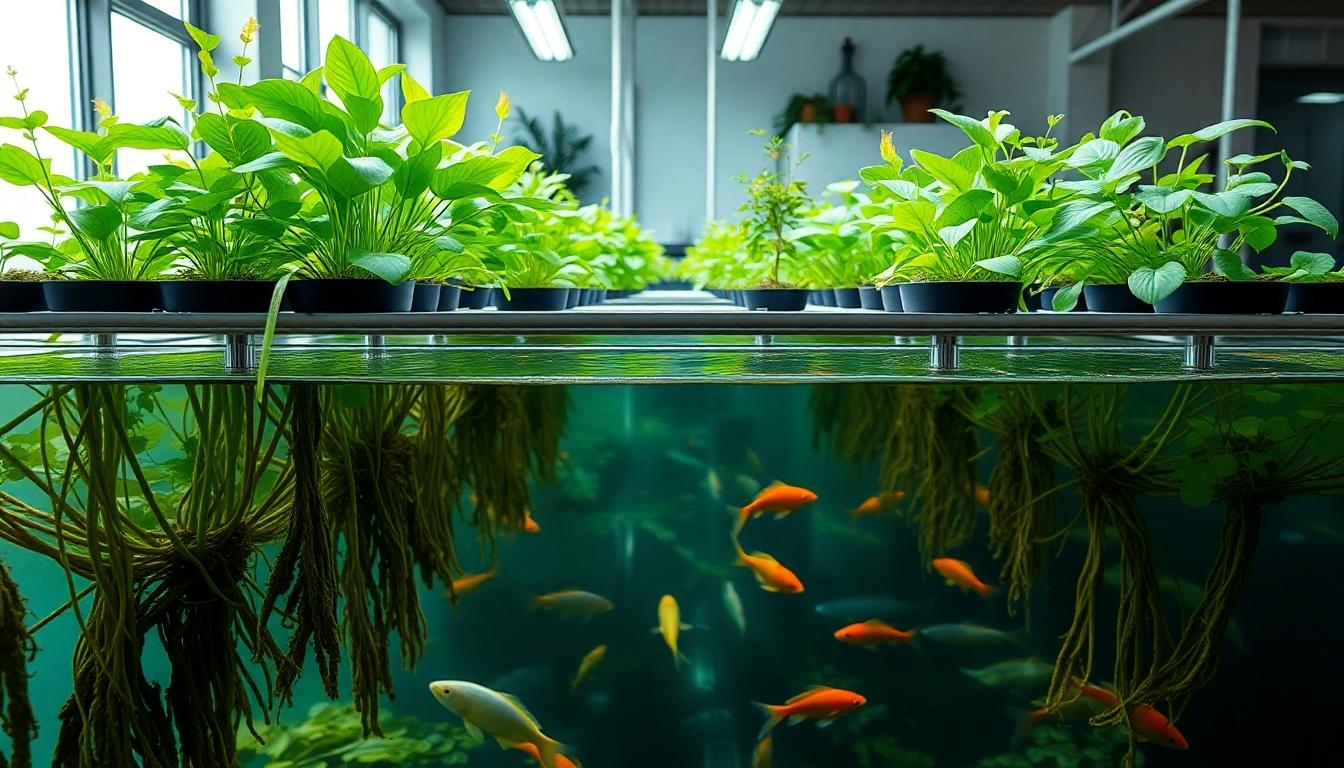
Aquaponics combines aquaculture (raising fish) and hydroponics (growing plants in water) to create a sustainable network where both fish and plants thrive together. Each method offers unique advantages and challenges depending on your space, budget, and growing goals.
Deep Water Culture (DWC) Technique
DWC systems feature floating rafts or Styrofoam boards where plants grow with their roots fully submerged in nutrient-rich water. This method boasts some of the highest yield potential among all aquaponics approaches, making it popular for commercial operations. Water circulation remains constant, providing plants with continuous access to fish-derived nutrients. The large water volume in DWC systems helps maintain stable temperatures and water chemistry, reducing daily fluctuations that can stress fish. Setting up this system requires important space and careful water stabilization to prevent rafts from flipping, which can damage plants and disrupt the growing environment.
Media Bed Method for Home Gardeners
Media beds use containers filled with growing medium such as clay pebbles or expanded shale where plants develop their root systems. This approach is particularly beginner-friendly, offering an easy setup process that’s perfect for home gardens and small-scale operations. The growing media provides excellent biological filtration, efficiently converting fish waste into plant nutrients while also supporting a diverse range of plant types. We’ve found that media beds work exceptionally well for growing larger plants that might not thrive in other aquaponics systems. Regular cleaning becomes necessary over time as the media can accumulate solids and become heavy, potentially requiring more structural support than other methods.
Nutrient Film Technique (NFT) Systems
NFT systems circulate a thin film of nutrient-rich water through long, narrow channels where plants grow with their roots partially submerged. This space-efficient design allows for high-density planting without requiring solid growing media, reducing overall system weight and maintenance. Plants receive excellent oxygen exposure in NFT systems, promoting healthy root development and nutrient uptake. Careful maintenance proves critical with this method, as the narrow channels can easily clog with root matter or fish waste if not properly managed. NFT works best with smaller plants that have limited root systems, such as lettuce, herbs, and other leafy greens.
Vertical Aquaponics Innovations
Vertical aquaponics stacks growing space upward rather than outward, maximizing production in limited footprints. This innovative approach can increase yields dramatically compared to traditional horizontal systems using the same square footage. The vertical orientation creates visually striking growing systems that work well in urban environments, living spaces, and areas where ground space comes at a premium. Plants receive excellent light exposure through careful positioning of growing surfaces at different heights. Initial setup costs tend to be higher for vertical systems due to specialized equipment and structural requirements. Water distribution needs careful engineering to ensure all plants receive adequate nutrients regardless of their position in the vertical stack.
Starting Your First Aquaponics System: A Step-by-Step Guide
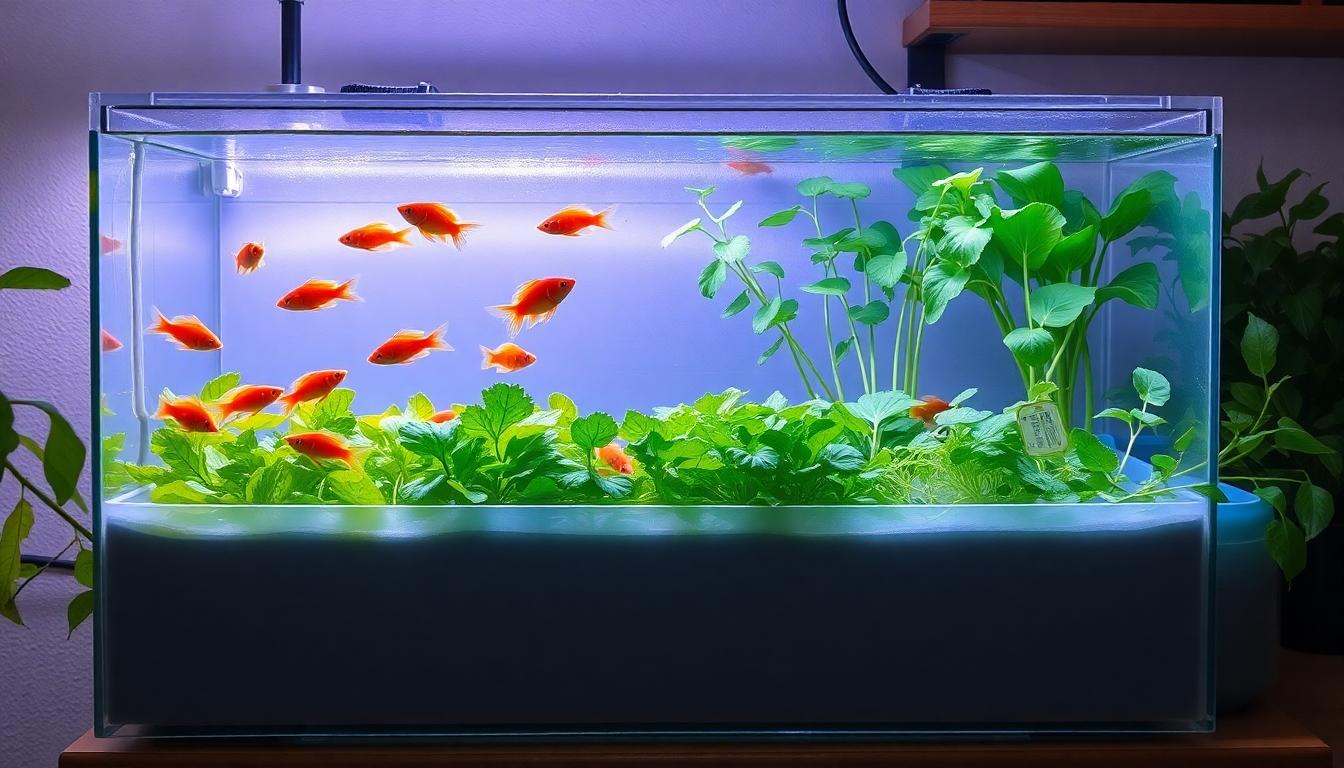
Aquaponics combines fish farming and plant cultivation in one integrated system, offering a sustainable way to grow both fish and plants simultaneously.
Planning and Design Considerations
- Choose the Right Location: Select a spot that receives adequate sunlight and allows easy access for maintenance of both your fish tank and grow bed components.
- Gather Essential Components: For beginners, we recommend starting with a 20-40 gallon fish tank that provides sufficient space for fish movement and waste production.
- Select Appropriate Growing Media: Clay pellets or gravel work excellently as growing mediums in your grow bed, supporting plant roots while allowing proper water flow.
- Install a Reliable Pump System: A simple pond pump connected to appropriate piping ensures proper water circulation between your fish tank and grow beds, maintaining the crucial nutrient cycle.
Cycling Your System Before Adding Fish
- Understand the Cycling Process: Cycling establishes the beneficial bacteria colony that converts toxic fish waste into plant nutrients, forming the foundation of your aquaponics network.
- Allow Sufficient Time: The cycling process typically takes 2-4 weeks to complete, requiring patience before introducing any fish to your system.
- Monitor Bacteria Development: During cycling, beneficial bacteria will colonize your growing media and begin converting ammonia to nitrites and eventually to nitrates.
- Test Before Adding Fish: Complete cycling is indicated when ammonia and nitrite levels drop to zero while nitrate levels rise, signaling your system is ready for fish introduction.
Maintaining Optimal Water Parameters
- Balance pH Levels: Keep pH between 6.8 and 7.2 to create an environment where both fish and plants can thrive optimally.
- Monitor Water Temperature: Different fish species require exact temperature ranges, generally between 60°F to 85°F, so select fish appropriate for your climate conditions.
- Test Ammonia and Nitrite Regularly: These compounds should remain at zero levels in a healthy system to ensure fish safety and system stability.
- Check Nitrate Concentration: Healthy nitrate levels indicate proper cycling and provide essential nutrients for plant growth throughout your system.
Troubleshooting Common Problems
- Watch for Feeding Issues: Overfeeding or underfeeding fish can quickly impact water quality, so adjust feeding schedules based on fish behavior and water test results.
- Address pH Fluctuations: Regular testing helps identify pH swings early, allowing for minor adjustments before they affect fish health or plant growth.
- Maintain Pump Functionality: Ensure your pump operates consistently to prevent water stagnation, which can quickly lead to oxygen depletion and system imbalance.
- Select Appropriate Fish Species: Hardy varieties like tilapia, goldfish, or ornamental fish tolerate fluctuations better, making them ideal choices for beginners learning system management.
- Start With Easy Plants: Begin with leafy greens, herbs, or small vegetables that adapt well to aquaponics conditions while you gain experience with system maintenance.
Commercial Aquaponics: Scaling Up the Fish-Plant Method
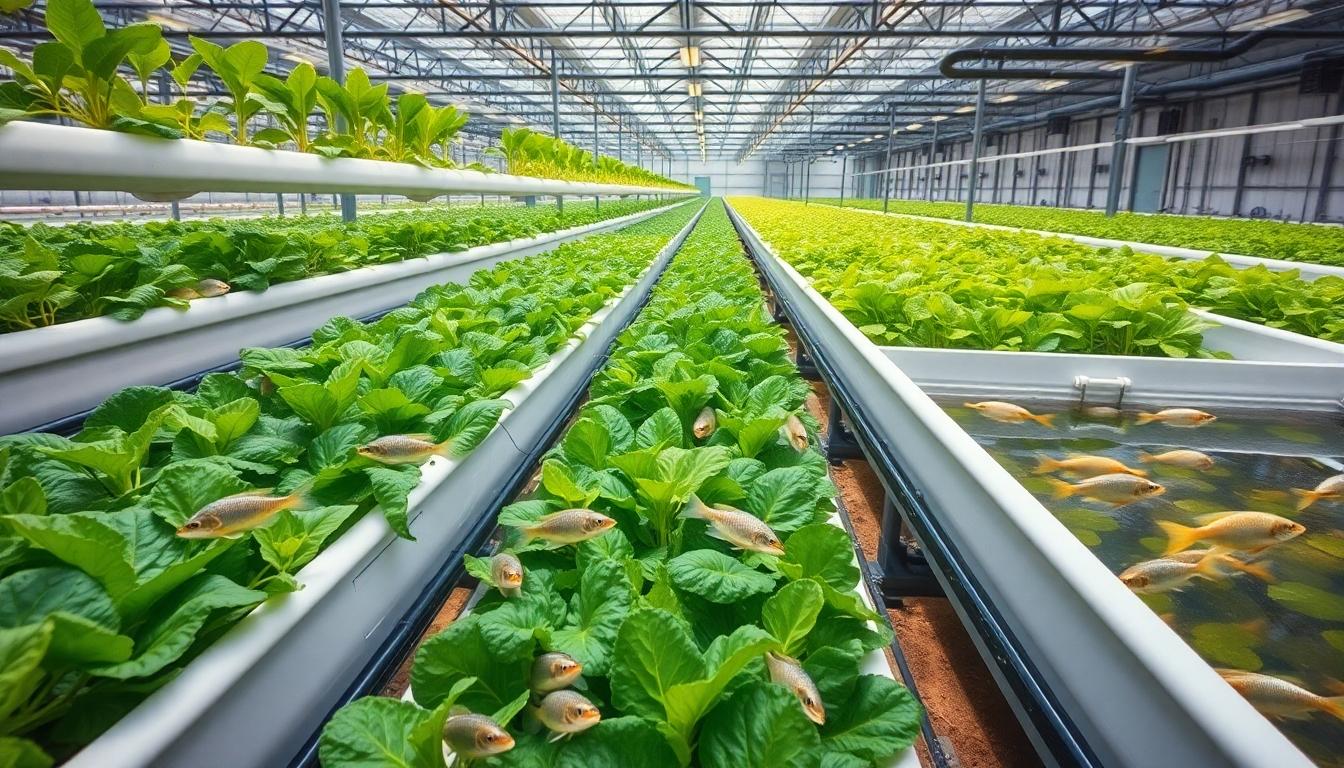
Economic Viability and Market Opportunities
Commercial aquaponics presents a compelling business opportunity by merging fish cultivation with plant production in an integrated system. Water efficiency serves as one of its major economic advantages, using up to 90% less water than conventional farming methods while enabling year-round production regardless of seasonal changes. Tilapia and leafy greens dominate the commercial aquaponics market due to their compatibility and high consumer demand. Strategic location near urban centers significantly reduces transportation costs, allowing businesses to deliver fresher products with lower carbon footprints. Producers can capitalize on premium pricing for locally grown, pesticide-free vegetables and sustainably raised fish, creating dual revenue streams from a single production system.
Case Studies of Successful Commercial Operations
Thriving commercial aquaponic farms often focus on high-value crop combinations such as specialty lettuces paired with tilapia. Food banks and missions have successfully implemented aquaponics systems to produce nutrient-dense foods for communities in need, demonstrating the social impact potential of this farming method. Nelson & Pade stands out as an industry leader, developing comprehensive commercial-scale systems that serve as blueprints for profitable operations. Their standardized models provide predictable production metrics, helping new entrepreneurs enter the market with greater confidence. Successful operations typically maintain balanced fish-to-plant ratios to maximize productivity while ensuring system stability.
Regulatory Considerations and Certifications
Commercial aquaponics operations must navigate regulations spanning both aquaculture and hydroponic farming sectors. Water quality standards require regular testing and documentation to ensure compliance with local and federal environmental regulations. Food safety certifications such as Good Agricultural Practices (GAP) and Good Handling Practices (GHP) enhance market access and consumer confidence in aquaponic products. Proper fish waste management systems need careful design to maintain ecological balance while meeting environmental standards. Certifications verifying organic or sustainable practices can unlock premium market segments where consumers willingly pay more for environmentally responsible food production. Documentation of water recirculation efficiency might be required in regions with strict water usage regulations, positioning aquaponics as a water-conservative alternative to conventional farming.
The Environmental Benefits of the Aquaponics Method
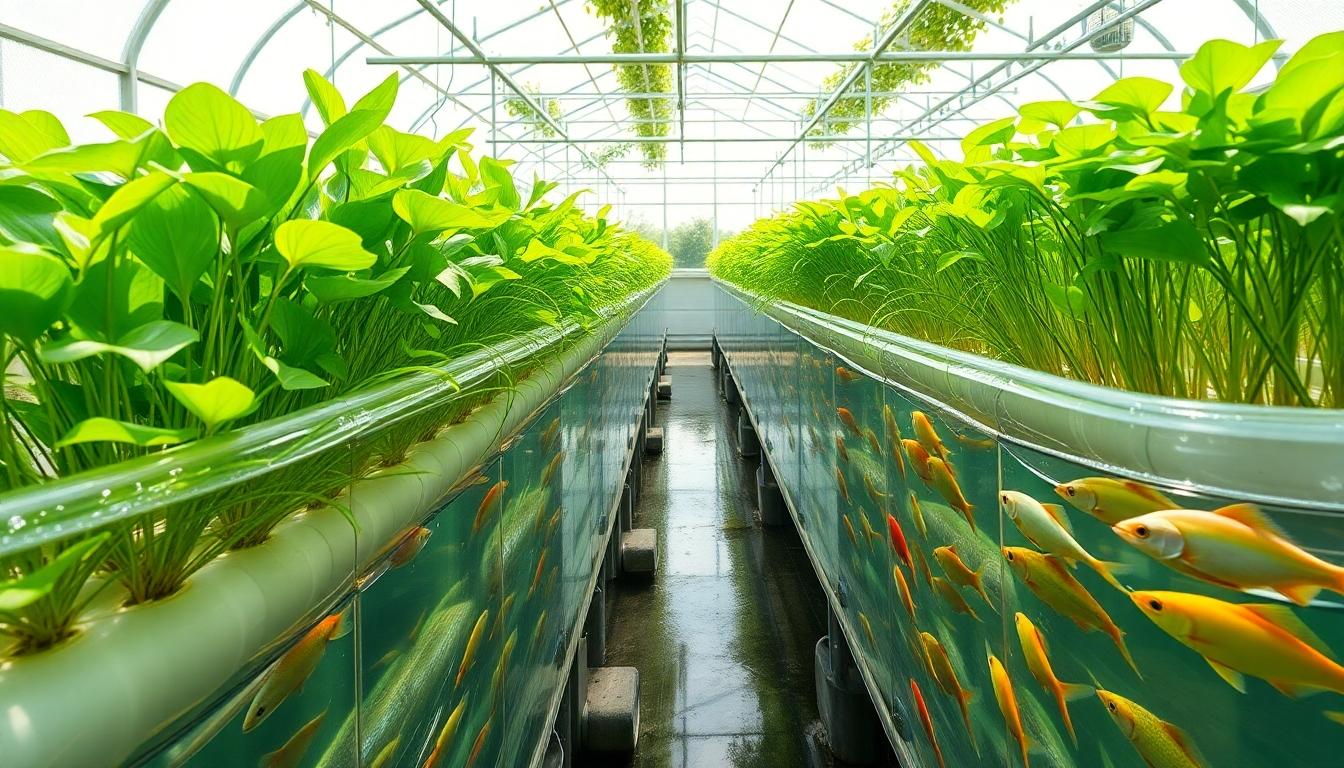
Water Conservation Advantages
Aquaponics systems dramatically reduce water consumption by using up to 90% less water than traditional soil-based farming methods. This remarkable efficiency makes aquaponics particularly valuable in regions facing water scarcity challenges. The system’s design capitalizes on water recirculation principles, continuously cycling the same water between fish tanks and plant beds. Water losses primarily occur through plant transpiration and minimal evaporation, rather than soil absorption or runoff that typically happens in conventional agriculture. By maintaining this closed-loop system, aquaponics ensures that water resources are utilized with maximum efficiency while still producing abundant crops and healthy fish.
Reduced Carbon Footprint
Aquaponics systems contribute significantly to reducing environmental impact, with studies indicating they can decrease environmental impact by up to 45%, including reductions in both fossil fuel usage and global warming potential. This efficiency comes from the integrated nature of the system, which eliminates many resource-intensive aspects of conventional farming. The carbon footprint can be further minimized when renewable energy sources power aquaponics operations. Many commercial aquaponics facilities have begun transitioning to solar or other sustainable energy options to enhance their environmental benefits. The integration of fish and plant production into a single system eliminates the need for heavy machinery commonly used in traditional agriculture, further reducing fossil fuel consumption.
Chemical-Free Growing Answers
Aquaponics relies on a natural nutrient cycle that eliminates the need for synthetic fertilizers and harmful pesticides. Fish waste serves as the primary nutrient source for plants, creating a perfect symbiotic relationship that benefits both organisms. This efficient nutrient recycling system prevents the nutrient runoff problems associated with conventional farming, which often leads to water pollution and harmful algal blooms in natural waterways. The absence of soil in aquaponics systems naturally minimizes soil erosion issues while simultaneously reducing environmental contamination from agricultural chemicals. Beneficial bacteria thrive in these systems, converting fish waste into plant-available nutrients and maintaining water quality naturally. The resulting produce is often cleaner and healthier than conventionally grown alternatives, making aquaponics an increasingly popular choice for environmentally conscious consumers and producers alike.
The Future of Aquaponics: Innovations and Trends
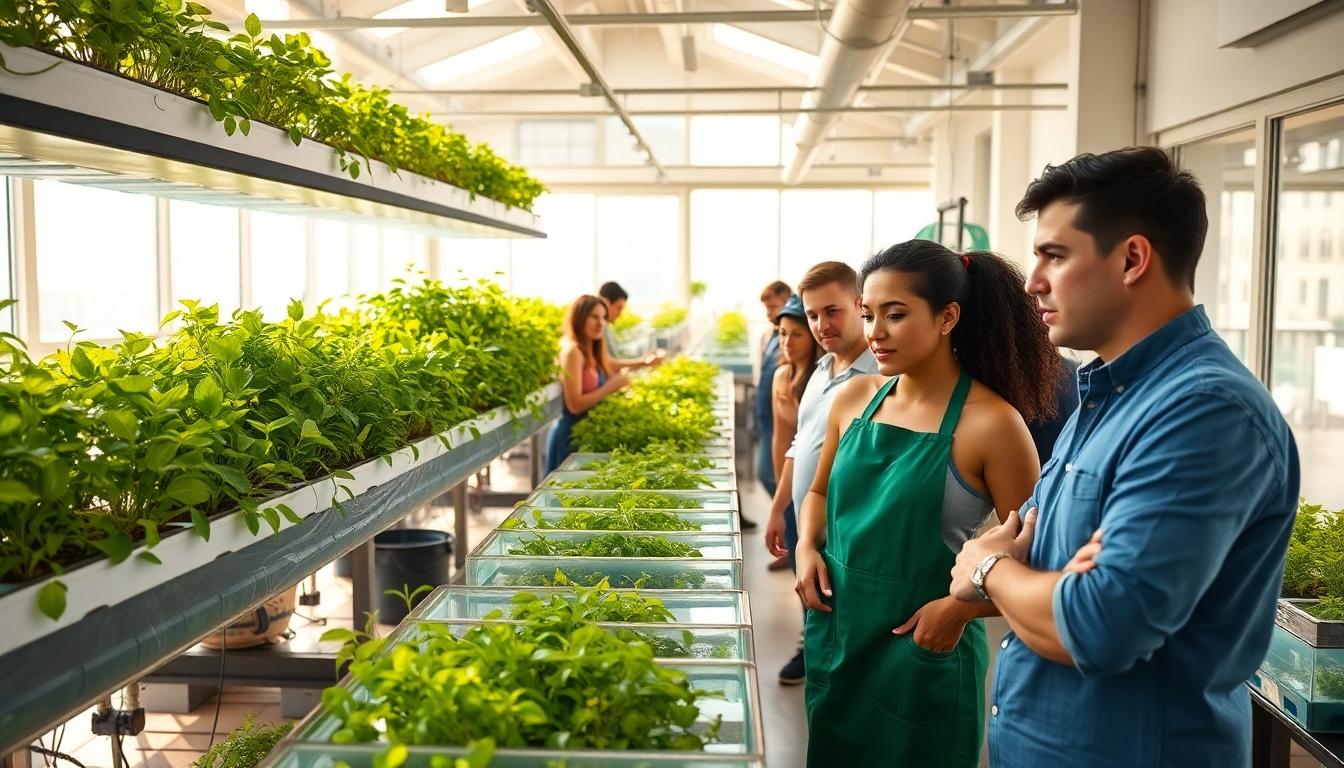
1. Integration of Advanced Technologies
The aquaponics industry is rapidly evolving with cutting-edge technology integration that’s transforming traditional systems into smart farming operations. IoT and smart sensors now allow farmers to monitor water quality, temperature, pH levels, and nutrient concentrations in real-time, creating optimal growing environments without constant manual testing. Artificial Intelligence applications have begun revolutionizing aquaponics by utilizing predictive analytics to anticipate system needs before problems arise. Automation technologies including robotic harvesting and computerized feeding systems significantly reduce labor costs while improving efficiency across operations of all sizes.
2. Urban Aquaponics
Urban environments are becoming hotspots for aquaponics innovation as space-efficient designs make local food production increasingly viable. Vertical farming techniques integrate multi-level aquaponic systems into urban buildings, dramatically reducing food transportation carbon footprints while maximizing limited city space. Community projects focusing on local food security have gained traction in metropolitan areas, providing fresh produce to food deserts and educational opportunities for residents. Rooftop systems transform previously unused urban spaces into productive green zones, contributing to cooler city temperatures while producing sustainable food sources above busy streets.
3. Market Growth
The economic outlook for aquaponics shows tremendous promise based on current market projections and consumer trends. Global aquaponics market value is expected to grow substantially from $1.82 billion in 2025 to $3.97 billion by 2035, representing an impressive 8.3% compound annual growth rate. This robust expansion reflects increasing consumer demand for locally grown, pesticide-free produce and sustainably raised fish products. Investment opportunities in this sector continue to attract both small entrepreneurs and large agricultural corporations looking to capitalize on efficient food production methods.
4. Sustainability and Education
Sustainability remains at the core of aquaponics development, with new systems emphasizing resource conservation and environmental responsibility. Educational initiatives have become crucial for widespread adoption, with workshops, online courses, and school programs teaching the principles of aquaponic farming to new generations. Universities have begun offering specialized degrees and research opportunities in aquaponic science, legitimizing the field and driving further innovation. Public awareness campaigns highlight how aquaponics addresses multiple environmental challenges simultaneously, building consumer support for products grown through this integrated method.
Conclusion: Is the Fish-Plants Aquaponics Method Right for You?
Aquaponics represents a revolutionary approach to sustainable food production that we can all benefit from. By harnessing the natural symbiosis between fish plants and beneficial bacteria this method offers remarkable water efficiency and chemical-free growing.
Whether you’re starting small with a home system or considering commercial production the principles remain the same. Success comes from understanding the delicate balance of the nitrogen cycle selecting appropriate fish and plant combinations and maintaining optimal conditions.
As technology advances and environmental concerns grow aquaponics stands poised to play a important role in our future food systems. It’s not just a growing method but a pathway to greater self-sufficiency and environmental stewardship that we can carry out today.
Frequently Asked Questions
What is aquaponics?
Aquaponics is a sustainable farming method that combines aquaculture (fish farming) and hydroponics (soil-less plant growing) in one integrated system. Fish waste provides nutrients for plants, while plants filter the water for fish. This symbiotic relationship creates a closed-loop ecosystem that uses 90% less water than traditional gardening and produces food more quickly.
Which fish are best for aquaponics?
Tilapia is the most popular choice due to its adaptability and consistent waste production. Other good options include catfish (high yield, tolerant of varying conditions), trout (for cooler climates), ornamental fish like goldfish and koi (for smaller systems), and native species like perch and bluegill. Choose based on your climate, system size, and local regulations.
What plants grow well in aquaponics?
Leafy greens (lettuce, kale, spinach) are ideal because they grow quickly and thrive on available nutrients. Herbs like basil, mint, and cilantro also perform excellently. Fruiting plants such as tomatoes and peppers can succeed in established systems with adequate nutrients. Avoid root vegetables and heavy feeders as they may struggle or disrupt system balance.
How much space do I need for an aquaponics system?
You can start with as little as a 20-40 gallon setup in a small space. Commercial systems require more room, but vertical designs maximize production in limited areas. The key is ensuring adequate space for both fish tanks and growing beds while maintaining proper fish stocking density (approximately 1 fish per 8-10 gallons) and sufficient growing media for plants.
How does the nitrogen cycle work in aquaponics?
The nitrogen cycle is the backbone of aquaponics. Fish produce ammonia-rich waste, which beneficial bacteria convert into nitrites and then into nitrates. Plants absorb these nitrates as nutrients for growth. This natural biological process eliminates the need for synthetic fertilizers while maintaining water quality for the fish, creating a self-sustaining ecosystem.
What equipment do I need to start an aquaponics system?
Essential components include a fish tank (20-40 gallons for beginners), grow beds with media like clay pebbles or gravel, a reliable pump for water circulation, plumbing to connect components, and monitoring equipment for pH, temperature, and nitrogen compounds. Additional items might include aeration systems, filters, and automatic feeders depending on system complexity.
How often should I monitor water quality?
Monitor water parameters at least twice weekly in established systems and daily when starting out. Check pH (aim for 6.8-7.0), temperature (based on fish species), ammonia and nitrite (should be near zero), and nitrate levels (10-150 ppm is ideal). Consistent monitoring enables early detection of potential issues, maintaining system stability for both fish and plants.
Which aquaponics method is best for beginners?
The Media Bed method is most beginner-friendly. It uses growing media (like expanded clay pebbles) that provides surface area for beneficial bacteria and supports a wide variety of plants. This method is forgiving of fluctuations, requires minimal components, and offers good filtration. Start with hardy fish like tilapia or goldfish and easy plants like lettuce and herbs.
How long does it take to cycle a new aquaponics system?
The cycling process typically takes 2-4 weeks. During this time, beneficial bacteria establish themselves and create the nitrogen cycle. Add a small amount of ammonia source (fish food or pure ammonia) to start the process, then monitor ammonia, nitrite, and nitrate levels. The system is cycled when ammonia and nitrite levels drop to zero and nitrates appear.
Is aquaponics commercially viable?
Yes, commercial aquaponics can be profitable with proper planning. It offers year-round production of high-value crops like tilapia and leafy greens. Commercial systems benefit from water efficiency, reduced labor costs, and premium pricing for organic produce. Success requires careful business planning, market research, regulatory compliance, and appropriate scale to achieve economically viable production volumes.

